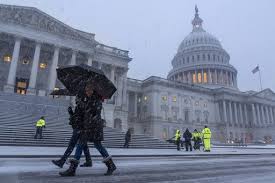March is shaping up to be one of the most unpredictable months Washington has seen in recent years. From relentless rain along the coast to unexpected snowfalls in the mountains and temperature swings that will keep residents guessing, the forecast suggests a chaotic mix of weather patterns that could impact travel, daily life, and even public safety. If you thought winter was winding down, don’t be too sure. While spring may technically be on the horizon, Washington’s weather isn’t ready to let go of winter just yet. Here’s what you need to know as we move into this turbulent month.
A Wet and Stormy Start: Rainfall Expected to Surge
March is typically one of the wettest months of the year for Washington, and this year is no exception. The Pacific Northwest is already dealing with an active storm pattern, and meteorologists warn that heavier-than-usual rainfall is expected throughout the month. Coastal areas—including Seattle, Tacoma, and the Puget Sound region—should prepare for relentless rain showers, with some storm systems capable of dropping multiple inches of rain in just a few days. While rainfall is a common part of life in Washington, the increased precipitation raises concerns about localized flooding, landslides, and hazardous driving conditions.
:max_bytes(150000):strip_icc():focal(614x379:616x381)/washington-flood-b6367b46fc6846c8956908344e8a7a99.jpg)
Snow in March? Yes, and It May Arrive Suddenly
While lower elevations will mostly see rain, higher elevations and even some inland areas could see a return of winter conditions. The Cascades, Spokane, and other eastern parts of the state have a strong chance of seeing snowfall, especially in the first half of March. Forecast models suggest that cold air from Canada could push southward, mixing with incoming moisture and resulting in a few surprise snowfalls—even at lower elevations. Residents in areas like Snoqualmie Pass and Stevens Pass should prepare for possible heavy snow, while those in central and eastern Washington may see a mix of rain and snow on select days.
Temperature Swings Will Keep Washingtonians on Their Toes
One of the biggest challenges of this month’s weather will be the dramatic temperature fluctuations. Washingtonians could see mild, almost spring-like conditions one day, followed by a sharp drop into freezing temperatures the next. Coastal areas will likely see daytime highs hovering between the mid-40s and low 50s°F, while inland and higher elevations will experience more extreme swings. In Spokane, for example, temperatures could drop as low as 20s°F at night, creating icy road conditions and potential travel hazards.
La Niña’s Influence: Why This Weather Is So Unpredictable
This chaotic weather pattern is being heavily influenced by a weak La Niña, a climate phenomenon where cooler-than-normal Pacific Ocean waters disrupt normal atmospheric conditions. Typically, La Niña brings cooler and wetter conditions to the Pacific Northwest, and that’s exactly what we’re seeing in Washington this March. Meteorologists say that this unpredictable mix of cold and moisture is why we’re seeing both rainstorms and sudden snow events. The weather could shift at a moment’s notice, making it crucial for residents to stay updated on forecasts and warnings.
How to Stay Safe and Prepared
With such volatile weather on the way, Washington residents should take extra precautions:
- Be Flood-Ready – If you live in a low-lying area, clear your storm drains and prepare for potential flooding. Avoid driving through standing water.
- Prepare for Snow – If you’re in a region prone to snow, keep winter supplies handy, including snow shovels, ice melt, and warm clothing.
- Dress for Anything – With temperatures swinging wildly, dress in layers to stay comfortable in both mild and freezing conditions.
- Check Road Conditions – Rain and snow could create hazardous driving conditions, especially in the mountains. If traveling, check pass conditions and be ready for delays.
- Monitor Weather Alerts – Conditions could change quickly, so stay informed by checking local forecasts daily.
Looking Ahead: A Gradual Shift to Spring
By mid-to-late March, Washington’s weather may start to stabilize, with fewer extreme temperature drops and less frequent storms. However, meteorologists caution that late-season snow events and heavy rains are still possible. Until then, expect the unexpected. Washington’s wild mix of rain, snow, and temperature swings will keep residents on their toes all month long. Whether you’re bracing for floods in the west or surprise snow in the east, one thing is certain—March will be a weather month to remember.

